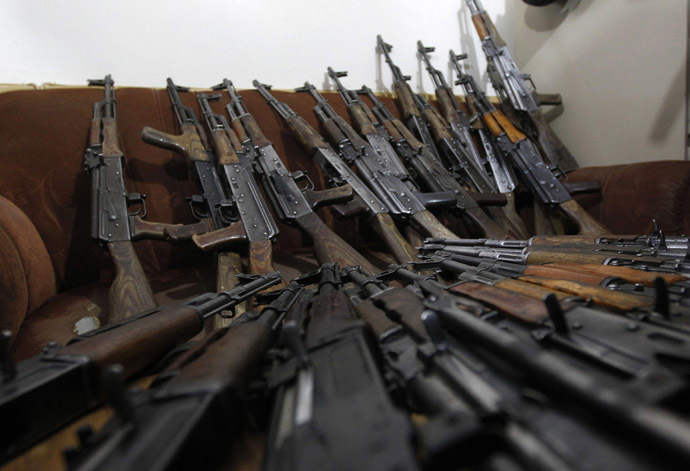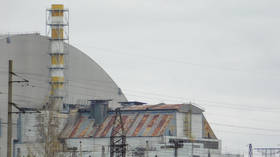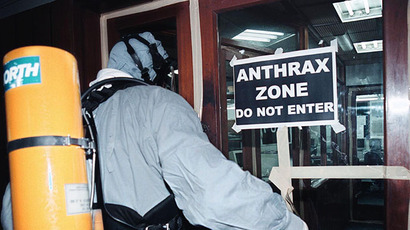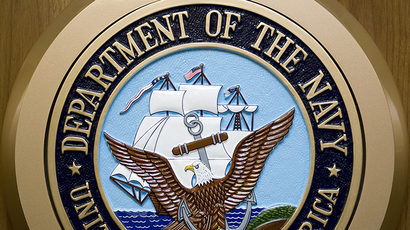Clandestine Navy directorate's officers go on trial over secret weapons program

Trials are set to begin this month for two men accused of conspiring to manufacture untraceable automatic-rifle silencers for a clandestine Navy office. The directorate is suspected of running a secret weapons program.
A little-known Navy intelligence office at the Pentagon called the Directorate for Plans, Policy, Oversight and Integration paid $1.6 million for 349 silencers from a hot-rod auto mechanic in California ‒ who is the brother of the directorate’s boss, according to charging documents. The untraceable weapons attachments cost only $10,000 in parts and labor to manufacture.
“According to the records that have been made public, the crux of the case is whether the silencers were properly purchased for an authorized secret mission or were assembled for a rogue operation,” the Washington Post’s Craig Whitlock reported.
‘Wanna-be spook-cops’
The directorate has fewer than 10 civilian employees, most of whom are retired military personnel. Its mission is to provide back-office support and oversight for Navy and Marine intelligence operations. But at some point, prosecutors say, the office shifted into a grey area of “wanna-be spook-cops,” a former senior Navy official familiar with the investigation told the Post.
“I know it sounds goofy, but it was like they were building their own mini law enforcement and intelligence agency,” he added.
A former senior Defense Department official agreed with that assessment.
“By design, that office is supposed to do a little more than policy and programmatic oversight,” the former defense official said. “But something happened and it lost its way. It became a case of the fox guarding the henhouse, and I suspect deeper issues might be in play.”
No-bid contract for untraceable silencers
In March, prosecutors charged Lee Hall, 52, of northern Virginia, and Mark Landersman, 53, of California, with conspiracy to illegally manufacture firearms, transport unregistered firearms in interstate commerce and commit mail fraud. Hall was also charged with theft of government money, according to a Justice Department statement.
Based on the recommendation of David W. Landersman, the senior director for the Navy office, Hall, a directorate employee, initiated a no-bid (or single source) contract with Landersman’s company, Advanced Machining and Engineering (AME), for the purchase of the silencers, which AME was not licensed to manufacture or sell. The attachments were manufactured and shipped without serial numbers, according to court records.

Prosecutors have said the silencers were acquired for a highly secretive military operation codenamed UPSTAIRS. The only information about the “special access program” in the prosecution’s court papers is that a directorate official told an unnamed witness that the silencers were intended for Navy SEAL Team 6, the elite commando unit that killed Osama bin Laden. But representatives for SEAL Team 6 told federal investigators they had not ordered the silencers and did not know anything about them, according to the court papers, the Post reported.
The badge that sparked an investigation
The investigation into the contract began in January 2013 when a directorate official Tedd Shellenbarger, showed up at a Defense Intelligence Agency office in Arlington and asked for a badge that would allow him to carry weapons on military property, according to prosecutorial statements. The request ‒ which raised suspicious because the Navy office dealt primarily with policy matters and lacked law enforcement powers ‒ prompted Naval Criminal Investigative Service (NCIS) to obtain a warrant to search the directorate’s offices at the Pentagon. Agents found badge materials and other documentation that led them to broaden their investigation, the Post reported.
As NCIS delved deeper into the directorate’s workings, the Navy’s investigative arm discovered emails and a paper trail pertaining to the $1.6 million, no-bid contract to buy the silencers from Landersman.
Destruction of evidence
The trials have been made more convoluted by the destruction of potential evidence. At a pretrial hearing, one of Mark Landersman’s defense attorneys accused the Navy of impeding the investigation by destroying a secret stash of automatic rifles that the silencers were designed to fit. Indeed, a stockpile of 1,600 AK-47-style rifles (collected overseas and stored in Pennsylvania) were destroyed, the Post reported. Those weapons, along with the untraceable silencers, could have been used by American or foreign forces without being linked to the United States, one source said.

Hall’s lawyers have also complained about the destruction of evidence, after two Navy security officers testified that they burned directorate papers in November 2013, just three days after Whitlock’s first article on the investigation was published. Francine Cox, one of the security officers, acknowledged that she was aware the Navy directorate was under scrutiny and that she had read the Post article shortly before burning the documents. But she said she did not think the papers were important.
“I didn’t think the information we had was pertinent,” Cox testified at a pretrial hearing in July. “If you don’t tell me to hold onto something, I don’t have to hold onto it.”
Hall said the burned documents were crucial to his defense, as they included handwritten notes and other papers showing he received approval for the purchase of the silencers from an undersecretary of the Navy.
“My notes would show I acted in good faith,” Hall testified at the July hearing.
District Court Judge Leonie M. Brinkema refused to drop the charges against the directorate employee, but chastised the Navy for destroying the documents.
“I don’t find any nefarious evidence, or evidence of bad intent, but it sure does look to the court like negligence,” she said.
Other conspirators?
So far, Hall and Mark Landersman are the only two who have been charged. Prosecutors have referred to David Landersman in court papers as a conspirator in the case, but he has not been charged. Shellenbarger and three other directorate officials were placed on leave due to the badge incident, but have not been indicted. Shellenbarger has cooperated with the investigation and may be called as a witness in Hall’s trial. He has since returned to work for the department.
Another Hall witness may be Robert C. Martinage, a former acting undersecretary of the Navy, who reportedly gave Hall verbal approval for the secret program. Martinage was forced to resign in January after investigators uncovered evidence that he engaged in personal misconduct unrelated to ‒ but discovered during ‒ the investigation into the silencers.














